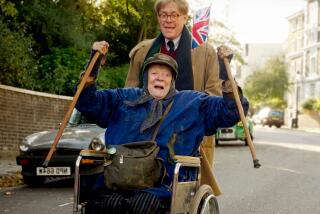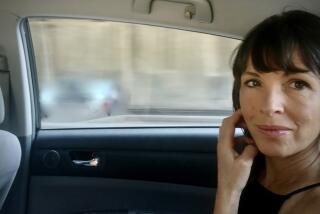Review: Ali Smith has double vision in ‘How to Be Both’
- Share via
Ali Smith’s sixth novel, “How to Be Both,” is a book of doubles, featuring twin narratives paired back to back and published in separate editions. In one, the first part evokes the 15th century Italian painter Francesco del Cossa and the second the contemporary saga of a British teenager named Georgia; in the other, these two stories are reversed.
That this is a gimmick goes without saying, and yet it is a gimmick that resonates. “[T]he first thing we see,” Smith writes late (or early) in the novel, “… and most times the only thing we see, is the one on the surface. So does that mean it comes first after all? And does that mean the other picture, if we don’t know about it, may as well not exist?”
What she’s describing is the art of the fresco, which was Del Cossa’s, and involves a certain tension between what are called “underdrawings” — think of them as basic sketches — and the finished work. The same could be said about this book.
Who comes first, Del Cossa or Georgia? It depends on which version of the novel you read. The idea, Smith wants us to understand, is that all stories, all pieces of art, are conditional, dependent on the observer’s gaze.
“Seeing and being seen … is rarely simple,” Georgia’s mother tells her, although this is another form of doubling because the older woman has already died. Memory, loss, meaning: These are the foundations on which “How to Be Both” is built, although to call it experimental is to miss the point. Rather it is deft and mischievous, a novel of ideas that folds back on itself like the most playful sort of arabesque.
Arabesques are Smith’s stock-in-trade, the essence of her voice. Her first novel, “Like” (1997), is also written in two parts and deals with themes of pairing, while her most recent, 2011’s “There But for The,” tells the story of a man who locks himself inside a bedroom at a party through the filter of four people with whom he interacts.
And yet “How to Be Both” — which was, like “Hotel World” and “The Accidental,” shortlisted for the Man Booker Prize — may have most in common with the author’s 2013 nonfiction book, “Artful,” which gathers four lectures on art and literature that turn the notion of the lecture on its head. Blending fact and fiction, Smith frames these lectures as something of an intellectual ghost story: The lecturer is dead. This mirrors the Del Cossa sections of “How to Be Both” (as well as, to some extent, the figure of Georgia’s mother), which the painter narrates from beyond the grave.
“[D]ear God dear Motherfather did I come the hard way back through the wall of the earth the stratifications the rocks and the soil the worms and the crusts the stars and the gods the vicissitudes and the histories the broke bits of forgettings and rememberings all the long road from gone to here,” he asks almost as soon as he returns to consciousness, in a museum in Cambridge, England, that houses one of his works. That he has been essentially forgotten is part of the intent here, the way we evaporate in time.
Smith never makes it clear how Del Cossa has come back, although the why is more easily understood: There is a bond between him and Georgia, whom he initially mistakes for a boy. “[I]t is as if a rope attached to the boy is attached to me,” he explains, “and has circled me and cannot be unknotted and where the boy goes I must go whether I want it or don’t, through a threshold, through another room.” He watches without comprehending as she stalks an older woman, dances, watches movies on an iPad, interacts with her brother and a friend.
Smith may be at her funniest describing the contemporary culture of the smart phone, which Del Cossa describes as populated by “people who have eyes and choose to see nothing, who all talk into their hands as the peripatate and all carry these votives, some the size of a hand, some the size of a face or a whole head, dedicated to saints perhaps or holy folk, and they look or talk to or pray to these tablets or icons all the while by holding them next to their heads or stroking them.” This is echoed in the Georgia section, when she and her friend Helena (or H) imagine what Del Cossa would think of cars. “Little prisons on wheels,” Georgia suggests, to which H responds, “Little confessionals on wheels. Everything for him would have been about God.”
The girls know about Del Cossa because of Georgia’s mother, who took her to Italy to see his frescoes just months before she died. Doubling again, but even more, a reflection on context, the ways meaning changes according to its moment, everything we do and do not know.
At the same time, Smith is after something bigger in this novel — the illusory nature of appearance itself. This emerges in the character of Georgia, often called George, the girl who looks like a boy, but even more in regard to Del Cossa, who we learn is a woman masquerading as a man.
That this is not historical truth is irrelevant; “How to Be Both” is a novel, after all. Even more, Smith wants us to consider: How much do we know about anyone in either the present or the past? “You can’t just make up stuff about real people,” Georgia tells H, but H rebuffs her: “We make stuff up about real people all the time.”
In part, the point is gender, sexuality: Who are we, the image the world perceives or the essence we know ourselves to be? But even more, it’s an existential issue, the realization that once enough time passes we all become figures of fiction, birth and death days long forgotten beneath the press of years.
For Del Cossa, rediscovered because he wrote a letter to his patron asking for more money, the line between remembrance and oblivion is especially thin. “Other than these,” he (or she) reflects, “we go out anonymous into the insect air and all we are is the dust of colour, brief engineering of wings towards a glint of light on a blade of grass or a leaf in a summer dark.” The same might be said of Georgia or of any one of us.
How to Be Both
A Novel
Ali Smith
Pantheon: 372 pp., $25.95
More to Read
Sign up for our Book Club newsletter
Get the latest news, events and more from the Los Angeles Times Book Club, and help us get L.A. reading and talking.
You may occasionally receive promotional content from the Los Angeles Times.







